Introduction
Hardly another economic sector is so tightly insulated from public scrutiny, few enterprises are more secretive than the banknote printing industry. The machinery and materials used in the production of banknotes may not be utilized elsewhere; the employees of the public and private banknote printing works are sworn to secrecy. And yet, despite the propagation of electronic means of payment and the supposed advent of the cashless society, the design of banknotes, methods of printing them and their security features are constantly evolving.
Begin with chapter 1Chapter 1
a european Identity
Types of currencies
What types of currencies has the world seen?
Commodity
Commodity
Commodity currencies are the oldest form of currencies. They are goods which have an inherent value such as food, cattle or tools. Though this means that they mostly cannot decrease in value, trading with commodity currencies is not easy. They aren't used in most modern societies, but are still widely spread in today's third world countries.since 4000 B.C.
Coin
Coin
Usually made of silver and gold, coins were the first form of currencies enforced by the authority of a government. This meant that governments now controlled the circulation of money and were able to manipulte the supply artificially, which led to many inflations and financial instabilities. since 640 B.C.
Paper
Paper
First introduced as notes of debt by European goldsmiths, paper money is convenient, easy to carry, widely accepted and will work in all circumstances regardless of the absence of a sophisticated technological infrastructure. Financial transactions conducted with banknotes cannot be electronically monitored: they are anonymous. since 1700 A.D.
Electronic
Electronic
Keeping in mind that money is only a representation of value, banks began to send information about transactions via telegraph and wire connections in the middle of the 20th century. Originally being only a perk for rich business men, the convenience made electronic money transfer widely popular by 1990, estimated to make up 92% of the world's total currency supply today. since 1950 A.D.
Even in todays digital world, having a physical currency is extremely important. People have always had and will always have the need to hold something in their hands, to feel and own. The design process behind our current Euro-Bills began in early 1994, when the European Monetary Institute put together the “Theme Selection Advisory Group”, consisting of experts of various fields, which would all contribute to mastering the various specifications of the forthcoming european currency.
The Theme Selection Advisory Group
The 15 members of the Advisory Group on the Selection of Design Themes
NAME
Select a member
NATIONALITY
Select a member
OCCUPATION
Select a member
These fifteen members had to find a way of guiding the creation of Europe's new currency. This meant incorporating nothing less than 1500 years of culture and history, a multitude of nations and the collective cultural identity of millions of people into seven banknotes. Normally, the visual appearance on banknotes aims to strengthen consciousness for national symbols, persons or landmarks. But not so in case of the euro: it is not a national, but a multinational currency, which led the Theme Selection Advisory Group to aim for a neutral approach, where no nation, gender or culture would feel favored or neglected.The group considered 18 themes which were evaluated against these and other criteria. In the end, the final themes were 'Ages and Styles of Europe" and "Abstract and Modern Design".
Providing the framework
The combined guideline for the style of Europe's new currency
Illustrated Era
Select a banknote
Dominant Color
Select a banknote
Measurements
Select a banknote
The finished guidelines were then given to the national central banks of all european countries. Every NCB could nominate designers, no matter if solo or in a team, to enter the competition. Up to the deadline, September 13th 1996, 29 designers or designteams handed in 27 entries for 'Ages and Styles of Europe' and 17 for 'Abstract and Modern Design'.All entries were then assessed against the acceptability criteria (meaning the acceptance of the design in all european countries), the legibility of the message (meaning the design should be understandable by everybody) and the artistic criteria (meaning the design should be artistically acceptable and aesthetically pleasing).
Selecting the winner
The Advisory Group's finalists
TOP 5Ages and Styles
YvesZIMMERMANN
RobertKALINA
ErnstJUENGER
LorliJUENGER
IngeMADLÉ
DanielBRUUN
JohannaBRUUN
TOP 5Abstract/Modern Design
KlausMICHEL
SanneJUENGER
RogerPFUND
RobertKALINA
MarykeDEGRYSE
TerryTHORN
Robert KALINAAustrian National Bank
was selected for:
Combination ofARCHITECTURE& ABSTRACT DESIGN
Clearly perceptibleEUROPEAN IDENTITY
Transportation of theEUROPEAN IDEA
Visually creatingTRUST
Chapter 2
Creating The Substrate
Creating the medium
The Cylinder Mould Process
The basic material is taken from leftover cotton from the clothing industry.
Cotton consists of fibers. These fibers are selected for length and durability. The collected substrate mass is then processed in the cylinder mould.
The Cylinder Mould
Hover over an item to find out more
Mechanicalcompression
Chemicalimpregnation
Hot foilstamping
Drying
Chapter 3
The Printing Process
Where the money is made
The location of the euro banknote printing sites
Vantaa, FL
Dublin, IRE
Gateshead, UK
Haarlem, NL
Brussels, BEL
Chantepie, FR
Chamalières, FR
Madrid, ESP
Carregado, POR
Berlin, GER
Leipzig, GER
Munich, GER
Vienna, AUT
Rome, ITA
Athens, GRE
Location
Select a location
Company
Select a location
Printer ID Code
Select a location
Printing Commissioners
Select a location
Four different printing methods are used in the Euro production: offset, intaglio, screen and relief printing. All of these methods are used to partially print each banknote, since each method is especially suited for particular optical and security requirements. Each substrate sheet is transported through a series of specialist printing machinery that sequentially prints selected elements and features, transforming the sheet into a matrix of printed banknotes.
Printing Procedures
What types of printing procedures are used?
STEP 2
The color from the lipophile parts of the printing plate is transferred onto a rubber blanket fixed around another spinning cylinder.
STEP 3
The color is finally transferred from the rubber blanket onto both front and back of the substrate simultaneously.
STEP 1
The oilbased color is applied to a prepared printing plate fixed around a spinning cylinder, where it only sticks to the oil attracting (lipophile) parts of the plate.
STEP 1
The color is injected into the indentations of the printing plate, which is again fixed around spinning cylinder.
STEP 2
The printing plate is pressed onto the paper and the color is absorbed and sticks to the substrate.
STEP 1
The optically variable color is spread onto a mesh covered with the printing pattern, leaving free only the parts which will be printed.
STEP 2
The color is pressed and thus forced through the empty spaces of the pattern, transferring the image onto the substrate.
STEP 1
The color is applied to the elevated parts of the special exchangeable printing elements.
STEP 2
The color is then simply pressed onto the substrate, to which it sticks. The printing element then changes certain digits of the printing pattern to form the next serial number.
Part 1: The OFFSET-PrintIt applies the background elements and is done in Super-Simultan printer presses, meaning both the front and back of the banknote are printed simultaneously.
After printing, the banknote sheets are cut into individual notes which are shrink-wrapped into bundles of several hundred banknotes each. Armed guards accompany the bundled, freshly printed notes as they are delivered in armored cash-in-transit vehicles to the National Central Banks.
Chapter 4
Exploring the Bill
The Security Features
Discover the various included security features
Front View
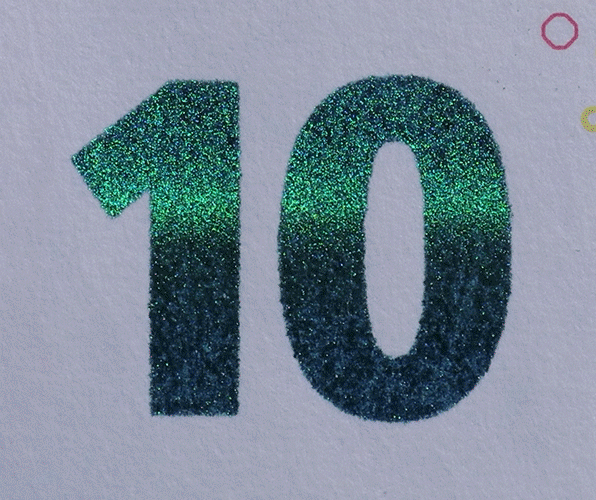
The Emerald Number
When tilting the banknote, the shiny number in the bottom left corner of the note displays an effect of the light that moves up and down. The number also changes colour from emerald green to deep blue.
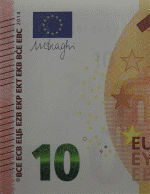
The Watermark
The watermark is produced by the varying thickness of the paper. A faint image becomes visible and shows a portrait of Europa (a figure from Greek mythology), the value of the banknote and a window appears when you hold the banknote against the light.

The Hologram
The hologram – the silvery stripe on the right of the banknote – reveals a portrait of Europa as well as the Euro symbol, a window and the numeral 10.
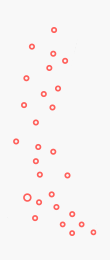
The Eurion-Constellation
A special arrangement of circles can be found on the bill. Position, size and color are checked not only by ATM machines, but also by printers and copiers to prevent scanning or reproduction.
The Silver Thread
The silver security thread is embedded in the new banknote. The security thread appears as a dark stripe when you hold the banknote against the light. The Euro symbol and the numeral 10 can be seen in tiny white lettering in that stripe.
The Printcode
Each banknote contains a 6-symbol printcode, which identifies the originally used printing plate from which it was produced.


The Reliefprint
Created by the relief print, the raised lines make it easy to identify the banknote, especially for visually handicapped people. Parts of the main image, the lettering and the large value numeral on the front of the banknote also feel thicker.
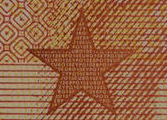
The Microprint
Some areas of the banknote feature a series of tiny letters: you will need a magnifying glass to see it. Although tiny in size, the microprinting is still sharp, and not blurred, an impressive printing feat.
Back View

The Microprint
As on the front, the back has several areas covered with letters and numbers in micro print.
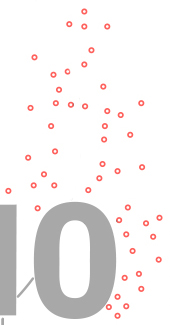
The Eurion-Constellation
Another arrangement of eurion-circles can be found on back, creating redundancy for the security feature.


The Banknote-Code
The probably best known security feature: the first character of the serial number is a letter which uniquely identifies the printer. The remaining 11 characters which, when their digital root is calculated, give a particular checksum.
These state of the art security features make counterfeiting an extremely difficult task. Yet this alone does not explain why everyone values these printed on pieces of cotton so much. So where does this perception of value come from?
Chapter 5
The Magic of Value
What is it really worth?
A comparison of material and face value
When the printed "banknote" leaves the printing press, it has a net value of 7 cents.
That is a fraction of 1 / 143 of €10.
Chapter 6
Ending the Cycle
The lifespan of a banknote
Assumed average lifetime of euro banknotes
5€
0,98 Animal equivalent: ladybeetle
10€
1,44 Animal equivalent: hamster
20€
1,51 Animal equivalent: hamster
50€
3,70 Animal equivalent: hedgehog
100€
6,94 Animal equivalent: rabbit
200€
9,40 Animal equivalent: budgie
500€
15,31 Animal equivalent: cat
The life expectancy of a banknote varies as a function of its face value: on the average, low denomination Euros are in circulation for one to two years, while a high denomination note may survive for a decade or more. But what happens to the amount of yearly 6 billion Euro notes that are not fit to be returned to circulation? Banknotes sorted out because of their poor material condition are destroyed in a shredding mechanism directly on the machine and their serial number erased from the list of genuine banknotes. However, banknotes that that are suspected to be counterfeits are turned over to the police for further investigation. Depending on the time of the year and the current economic situation some 20 - 40% of the notes are destroyed during processing. And of course, these notes must be replaced by freshly printed notes.
Epilogue
What lies ahead?
list of references:
- [1] ECB - How the Euro became our Money (viewed 11 May 2014)
- [2] Deutsche Bundesbank (viewed 23 April 2014)
- [3] Giesecke & Devrient (viewed 23 April 2014)
- [4] Wikipedia - Euro Banknotes (viewed 25 April 2014)
- [5] International Association of Currency Affairs (viewed 2 May 2014)
- [6] The Euro: Our Money - Official Website of the ECB (viewed 10 April 2014)
- [7] ECB: Eurosystem - Data & Statistics (viewed 5 May 2014)
- [8] How the Euro Works (viewed 8 May 2014)
- [9] Theme Advisory Group - Theme Report (viewed 22 April 2014)
- [10] ECB: Design of the first Euro Series (viewed 14 April 2014)
- [11] Counterfeit Money Detection: Know How (viewed 3 May 2014)
- [12] New Money (viewed 30 June 2014)
- [13] Swiss National Bank (viewed 14 April 2014)
- [14] Admirable Design (viewed 30 June 2014)
- [15] Bender, Klaus: Geldmacher. WILEY-VCH Verlag GmbH & Co. KGaA, Weinheim, 2004
- [16] Fergusson, Adam: When Money Dies. William Kimber & Co. Ltd., 1975